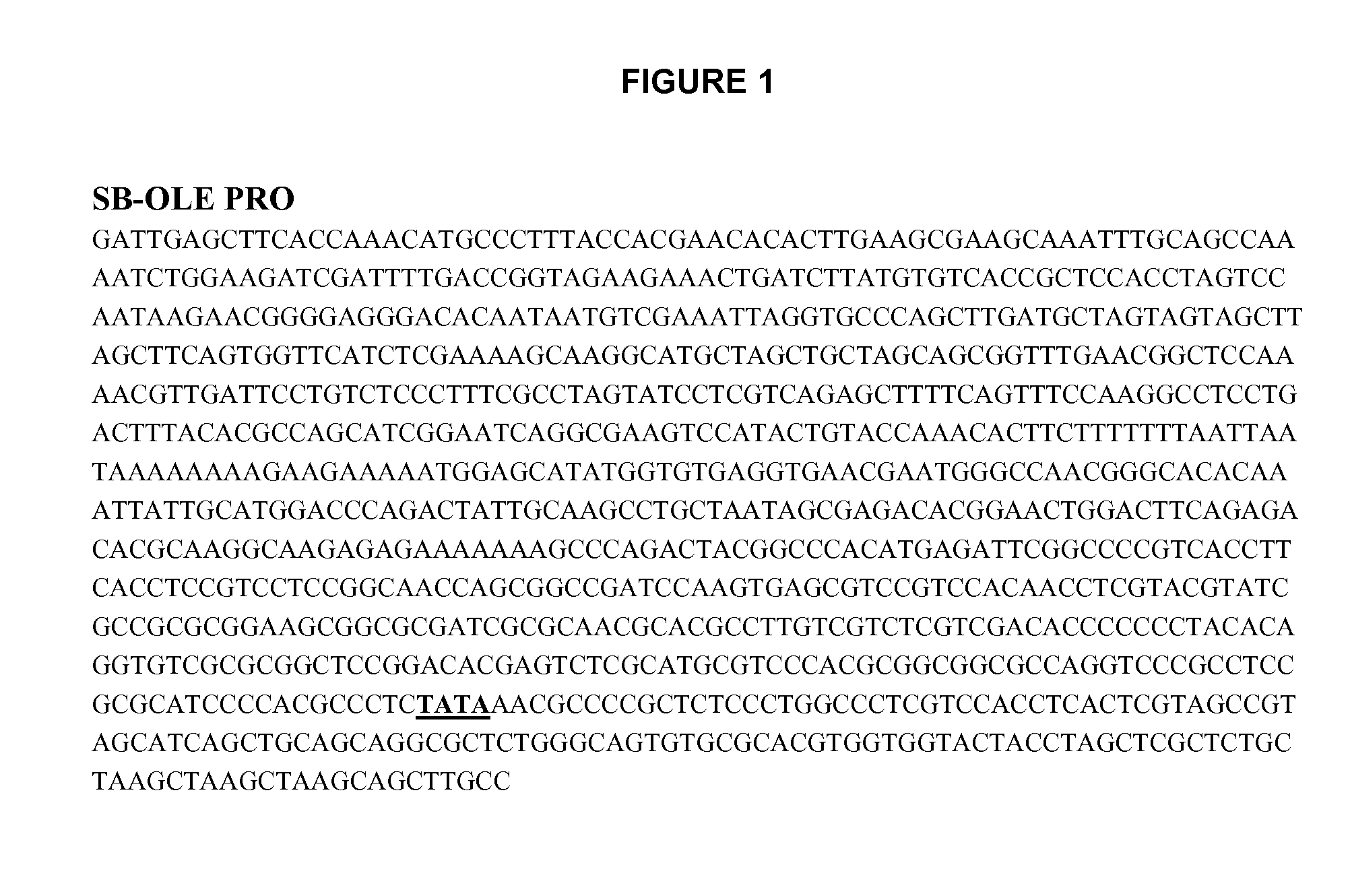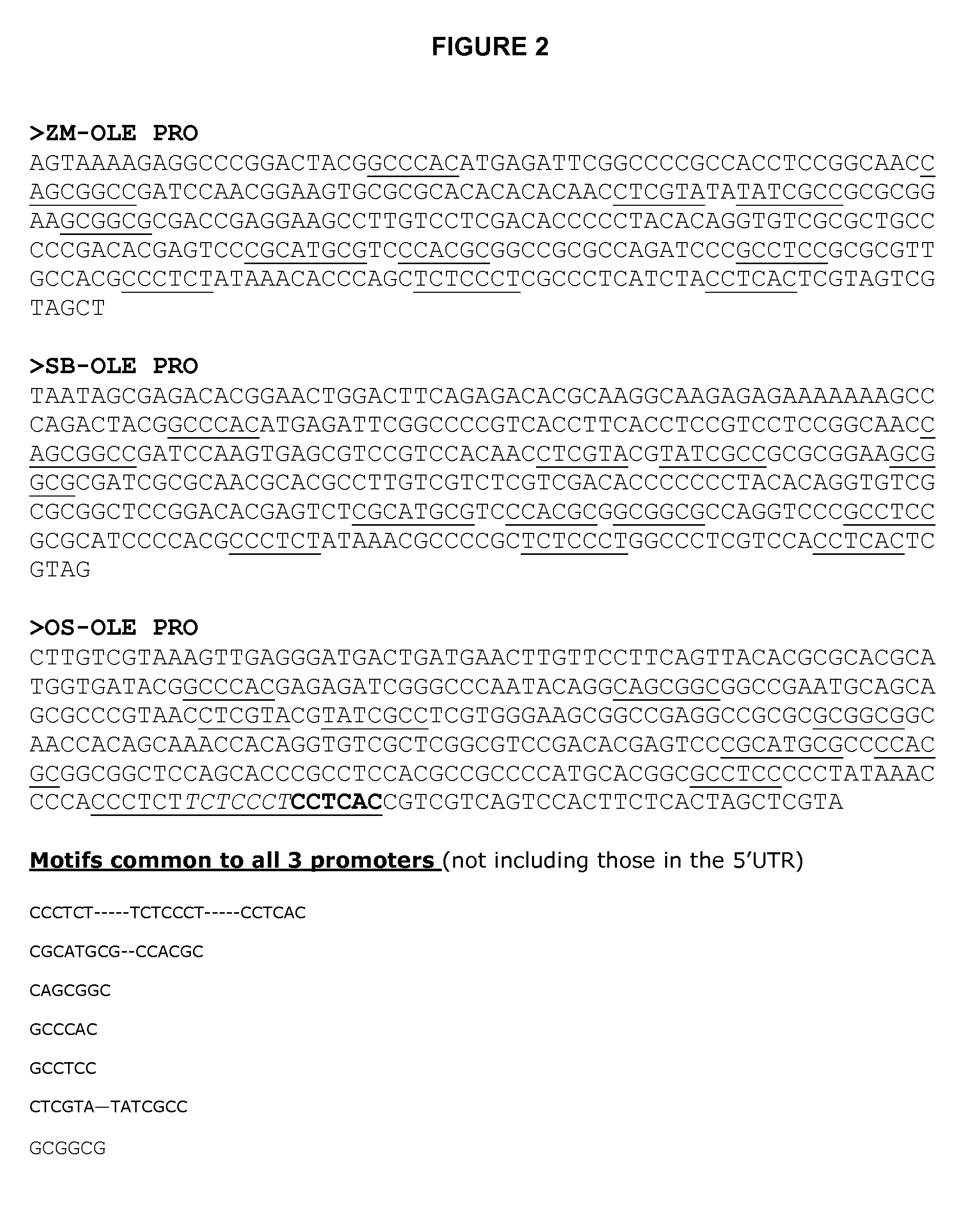Seed-Preferred Regulatory Elements
a technology of seed-based elements and regulatory elements, applied in the field of plant molecular biology, can solve problems such as the influence of one or more genes on the expression of genes
- Summary
- Abstract
- Description
- Claims
- Application Information
AI Technical Summary
Benefits of technology
Problems solved by technology
Method used
Image
Examples
example 1
Isolation of Regulatory Sequences
[0068]Regulatory regions from sorghum SB-OLE (Sorghum bicolor oleosin protein) were isolated from sorghum plants and cloned. Sorghum SB-OLE was selected as a source of seed preferred regulatory elements based on the spatial and temporal expression of its products.
[0069]The promoter is a 948 base pair nucleotide sequence, shown in FIG. 1 with the TATA box underlined. A BLAST of GenBank showed the highest identity was 59% to GenBank accession number U13701 (GI:687244) by Lee and Huang, “Zea mays oil body protein 16 kDa oleosin (ole16) gene, complete cds” 1995; and Lee and Huang (1994), supra. A region of 433 base pairs in the 3′ region of the sequence indicates 78% identity. A comparison is shown in FIG. 2 of the Zea mays oleosin promoter (SEQ ID NO: 3, the Sorghum oleosin promoter (SEQ ID NO: 1) and the Oryza sativa (SEQ ID NO: 2) oleosin promoter.
[0070]Motifs were identified that were common to all three oleosin promoters, thus indicating the importa...
example 2
Expression Data Using Promoter Sequences
[0075]A construct, named PHP28986, was prepared which included the sorghum oleosin promoter (SEQ ID NO:1) linked with the YFP selectable marker, supra and the nos or nopaline synthase transcription terminator (Depicker et al. (1982) J. Mol. Appl. Genet. 1(6):561-573; Shaw et al. (1984) Nucleic Acids Research Vol. 12, No. 20, pp. 7831-7846). All vectors were constructed using standard molecular biology techniques (Sambrook et al., supra). Successful subcloning was confirmed by restriction analysis.
example 3
Transformation and Regeneration of Maize Callus Via Agrobacterium
[0076]Constructs used were as those set forth supra using a binary plasmid with the left and right borders (see Hiei et al., U.S. Pat. No. 7,060,876) and the selectable marker for maize-optimized PAT (phosphinothricin acetyl transferase). Jayne et al., U.S. Pat. No. 6,096,947.
Preparation of Agrobacterium Suspension:
[0077]Agrobacterium was streaked out from a −80° frozen aliquot onto a plate containing PHI-L medium and was cultured at 28° C. in the dark for 3 days. PHI-L media comprises 25 ml / l Stock Solution A, 25 ml / l Stock Solution B, 450.9 ml / l Stock Solution C and spectinomycin (Sigma Chemicals) was added to a concentration of 50 mg / l in sterile ddH20 (stock solution A: K2HPO4 60.0 g / l, NaH2PO4 20.0 g / l, adjust pH to 7.0 w / KOH and autoclaved; stock solution B: NH4Cl 20.0 g / l, MgSO4.7H2O 6.0 g / l, KCl 3.0 g / l, CaCl2 0.20 g / l, FeSO4.7H2O 50.0 mg / l, autoclaved; stock solution C: glucose 5.56 g / l, agar 16.67 g / l (#A-70...
PUM
| Property | Measurement | Unit |
|---|---|---|
| Atomic weight | aaaaa | aaaaa |
Abstract
Description
Claims
Application Information
 Login to view more
Login to view more - R&D Engineer
- R&D Manager
- IP Professional
- Industry Leading Data Capabilities
- Powerful AI technology
- Patent DNA Extraction
Browse by: Latest US Patents, China's latest patents, Technical Efficacy Thesaurus, Application Domain, Technology Topic.
© 2024 PatSnap. All rights reserved.Legal|Privacy policy|Modern Slavery Act Transparency Statement|Sitemap


